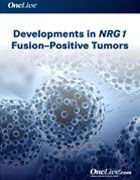Publication
Video
Special Issues
Dr. Liu on NRG1 Fusions in Oncology
Stephen Liu, MD, associate professor of medicine, Division of Hematology and Oncology, Georgetown University Medical Center, discusses the prevalence of NRG1 fusions in oncology.
Stephen Liu, MD, associate professor of medicine, Division of Hematology and Oncology, Georgetown University Medical Center, discusses the prevalence of NRG1 fusions in oncology.
NRG1 fusions are rare oncogenic drivers that occur across tumor types, including non—small cell lung cancer, breast cancer, colon cancer, pancreatic cancer, and cholangiocarcinoma. However, inhibition of the pathway that is responsible for the development of the NRG1 fusion can result in significant antitumor effects. Several case reports have shown that afatinib (Gilotrif), a pan-ERBB inhibitor, can induce rapid and durable responses, says Liu.
These data points suggest that NRG1 fusions are a viable target in oncology. In order to accurately identify an NRG1 fusion, RNA-based sequencing is necessary. Once identified, patients with an NRG1 fusion can enroll in the TAPUR trial to gain access to afatinib. However, this is not the only agent that is under evaluation, adds Liu. Notably, agents targeting HER3, monoclonal antibodies, bispecific antibodies, and antibody-drug conjugates are also under investigation. Research exploring such strategies is necessary as current approaches may be insufficient, he concludes.










